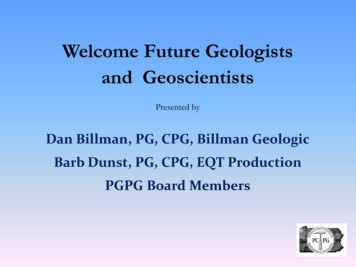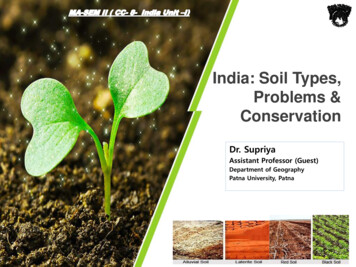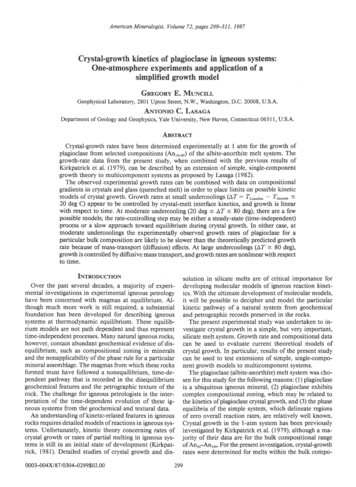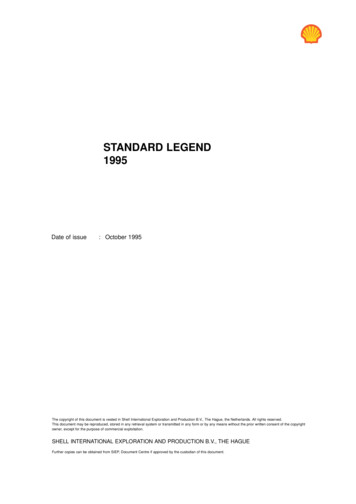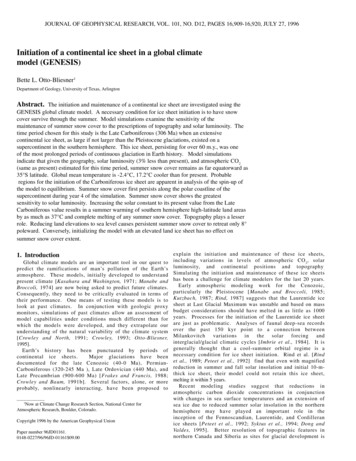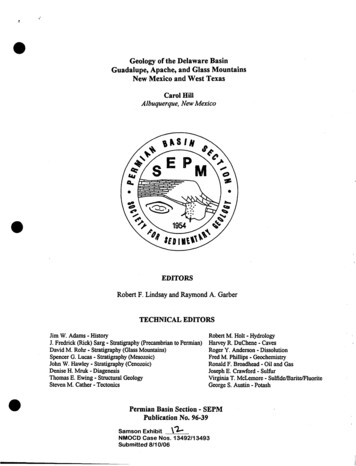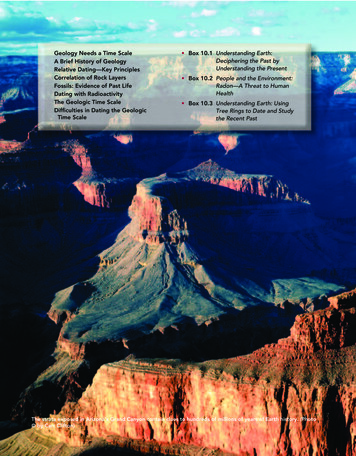
Transcription
THE USE OF GEOLOGY ON THE WESTERN FRONT.1By ALFRED H.INTRODUCTION.Before the end of the war nearly all activeAmerican geologists were engaged in work directly or indirectly connected with militaryproblems. The many fields of activity openedto geologists by the emergency iricluded servicewith troops, administration of war activities,national economics, relief work, military education, and, above all, applied geology. Thesuccess achieved by the American geologist insuch strongly contrasting duties bears testimony to his broad interests and wide experience and shows that he did his full part in thegreat struggle. This record also shows theeducational value of geologic training, for ithas made clear that such training develops thementAl power necessary to success in new fieldsof endeavor. It is also true, as shown by therecord, that while the geologj,st has the mentalequipment and experience to render valuableservice during war in many different capacities,yet his most important duties will be to determine the sources of minerals which the militarysituation renders especially necessary. Thisfact is here emphasized because it has beenassumed by some that the application of geology to war is limited to the work done on thebattlefield. As a matter of fact, the work ineconomic geology done on this side of tp.eAtlantic contributed more to the successfultermination of the war than that of the geologists in France. The Germans, too, recognized this fact, for a large part of the geologiststhey called into military service were engagedin the investigation of mineral resources. Manygeologists in both France and England wereengaged in a similar service.The following is a partial list of publicationsin which reference is made to the war work ofAmerican geologists:BROOKS.ALDEN, W. C., The country around Camp Upton (text onback of topographic map), New York: Map of Moriches quadrangle (Camp Upton edition), U.S. Geol.Survey, 1918.BASTIN, E. S., War-time mineral activities in Washington:Econ. Geology, vol. 13, pp. 524--537, 1918.BATEMAN, A.M., Military and geologic mapping---a planetable: Geol. Soc. America Bull., vol. 30, pp. 405-414,1919.- - The geologist in war time-the training of artillery ·officers: Econ. Geology, vol. 12, pp. 628-631, 1917.BERKEY, C. P., Engineering geology during and after thewar (abstract): Geol. Soc. America Bull., vol. 30, p. 81,1919.BLiss, E. F., Some problems of international readjustments of mineral supplies as indicated in recent foreign literature (abstract): Geol. Soc. America Bull.,vol. 30, pp. 101-102, 1919.BROOKS, A. H., Influence of geography on the conduct ofthe war (abstract): Educational Congress, Dept. Public Instruction of Pennsylvania, 1919, Proc., pp.540-547, Harrisburg, 1920.- - Military mining in France: Eng. and Min. Jour.,vol. 109, pp. 606-610, 1920.- - T h e application of geology to war (abstract): Eng.a.nd Min. Jour., vol. 109, p. 764, 1920; WashingtonAcad. Sci. Jour., vol. 10, pp. 331-333, 1920.- .- TheLorraine iron field and the war: Eng. a.nd Min.Jour., vol. 109, pp. 1065-1069, 1920.BuTTs, CHARLEs, The country in and around Camp Taylor (text on back of topographic map): Map of CampTaylor and vicinity, Ky., U. S. Geol. Survey, 1918.CAMPBELL, M. R., The country around Camp Shernlan. ·(text on back of topographic map): Map of CampSherman quadrangle, Ohio, U.S. Geol. Survey, 1918.CRoss, WHITMAN, Geology in the World War and after:Geol. Soc. America Bull., vol. 30, pp. 165-188, 1919.DAvis, W. M., Handbook of northern France, Cambridge,1918.DAy, A. L., Annual report of the Director of the Geophysical Laboratory: Carnegie Inst. Washington Yearbook, 1917, pp. 135-137, 1918.DEWOLF, F. W., The outlook for geology and geography:School Science and Mathematics, vol. 19, pp. 391-397,Chicago, 1919.GREGORY, H. E. [editor], Milital'ygeologyand topography,New Haven, Conn., 1918.- - Geology in the Student Army Training Corps (abstract): Geol. Soc. America Bull. vol. 30, pp. 81-82,1919.ALDEN, W. C., The country around Camp Albert L. Mills(text on back of topographic map), New York: Map HEWETT, D. F., Manganese ore as a war mineral (abstract):Geol. Soc. America Bull. vol. 30, pp. 97-98, 1919.of Camp Mills quadrangle, U. S. Geol. Survey, 1918.tPresented inab tractbefore the Geological Society of America Pee. 31, 1919.85
86SHORTER CONTRIBUTIONS TO GENERAL GEOLOGY, 1920.JoHNSON, D. W., 'Iopography and strategy in war, NewYork, 1917.- - - Some recent books on military geography: Geog.Review, vol. 9, pp. 60-63, 1920.LEE, C. H., Water resources in relation to military operations: Military Engineer, vol. 12, pp. 285-289, 1920.LEITH, C. K., Internationalization of mineral resources(abstract): Geol. Soc. America Bull., vol. 30, pp. 107·108, 1919.!;EVERETT, FRANK, The country around Camp Custer(text on back of topographic map): Map of Camp Custer quadrangle, Mich., U. S. Geol. Survey, 1918.LoUGHLIN, G. F., Rock products and the war (abstract):Geol. Soc. America Bull., vol. 30, p. 97, 1919.MATTHES, F. E., The country around Camp Mc(Jlellan(text on back of topographic map): Map of Annistonquadrangle, Ala., Camp McClellan edition, U. S.Geol. Survey, 1918.·· - - The country around Camp Gordon (text on backof topographic map): Map of Camp Gordon and vicinity, Georgia, U. S. Geol. Survey, 1918.MERTIE, J. B., jr., Present status of phototopographicmapping from the air: Eng. News Record, vol. 82,pp. 996-999, 1919.MoFFIT, F. H., Methods used in aero-phototopographicmapping (review): Eng. Newf! Record, vol. 82, pp.1000-1.004, 1919.MooRE, R. C., The environment of Camp Funston, witha chapter on the western theater of war, by Maj. D. W.Johnson: Kansas Geol. Survey Bull. 4, Topeka, 1918.PAIGE, SIDNEY, United States Geological Survey as a civicinstitution during war (abstract): G 01. Soc. AmericaBull., vol. 30, pp. 78-79, 1919.PoGuE, J. E., Mineral resources in the war and their bearing on preparedness: Sci. Monthly, vol. 4, pp. 120124, 1917.- - Military geology: Science, vol. 46, pp. 8-10, 1917.SALISBURY, R. D., and BARROws, H. ·H., The environment of Camp Grant, Ill.: :illinois Geol. Survey Bull.39, 1918.SHAW, E. W., Mexican petroleum and the war (abstract):Geol. Soc. America Bull., vol. 30, pp. 109-110, 1919.SMITH, G. 0., Our mineral reserves, in American problemsof reconstruction, edited by E. 1\L Friedman, pp. 5997, New York, 1918.- - U . S . Geol. Survey Thirty-eighth Ann. Rept., pp.7-9, 1917.- - U. S. Geol. Survey Thirty-ninth Ann. Rept., pp.7-10, 1918.---U.S. Geol. Survey Fortieth Ann. Rept., pp. 7-10,1919.- - The strategy of Ininerals, New York, 1919.---- EconOinic limits of domestic independence inminerals (abstract): Geol. Soc. America Bull., vol. 30,pp. 98-100, 1919.- - Military contributions of civilian engineers, Geol.Soc. America Bull., vol. 30, pp. 389-404, 1919.SMITH, P. S., The geologist in war times: The United· States Geological Survey's war work: Econ. Geology,vol. 13, pp. 392-399, 1918.SMITH, W. D., War work by the department of geology atthe University of Oregon (abstract): Geol. Soc.America Bull., vol. 30, p. 83, 1919.SPURR, J. E., War minerals: Econ. Geology, vol. 13, pp.500-511, 1918.- - Commercial control of the mineral resources of theworld (abstract): Geol. Soc. America Bull., vol. 30,pp. 108-109, 1919.- - The commercial control of the Inineral resourcesof the world; its political significance: Sci. Monthly,vol. 6, pp. 73-82, 1919.STEPHENSON, I . \V., and MISER, H. D., Camp Pike andthe adjacent country (text on back of topographicmap): Map of Little Rock quadrangle, Ark., CampPike edition, U. S. Geol. Survey, 1918.STONE, R. W., Phosphate rock an economic army (abstract): Geol. Soc. America Bull., vol. 30, p. 104, 1919.UMP EBY, J. B., World view of mineral wealth (abstract):Geol. Sec. America Bull., vol. 30, p. 107, 1919.VAUGHAN, T. W., Geologic surveys and the eradication ofmalaria: Southern Med. Jour., vol. 11, pp. 569-572,Birmingham, Ala., 1918.- - - Presentation of geologic information for engineer ing purposes (abstract): Geol. Soc. America Bull., vot30, pp. 79-80, 1919.WRIGHT, F. E., War-time development of the optical industry: Optical Soc. America Jour., vol. 2-3, pp. 1-7,1919.Although geologic investigations in areasfar behind the front must always be of greatimportance during war, yet it is now definitelyestablished that the geologist can render anessential service at and near the front. Thefact that a knowledge of geology may proveto be the decisive factor in a given militaryoperation was made evident only during thelate war and by no means found general acceptance among military leaders.An exposition of the use of geology during thewar should be prefaced by the statement thatwhile the science was definitely recognized inseveral of the armies, it was by no means developed to its full usefulness, not so much because of the failure to organize geologic staffsor to give support to geologic investigations, asbecause of the failure to apply the resultsachieved and to seek the advice of the geologiston problems that clearly lay within his field.Relatively few officers of the high commandsof the several armies that employed geologistshad any adequate conception of the applicationof geology to military and engineering problems. So far as geology was thought of at all,it was regarded by many as a purely speculative and abstract rather than as a practical andconcrete science. The geologic officers of all thearmies had to spend much time and energy incombating such ignorance and prejudice. Thismade the service particularly hard, for it was
USE OF GEOLOGY ON THE WESTERN FRONT.discouraging to see the cheerlul undertaking ofimpossible projects, involving the needless expenditure of time and energy and only too oftenuseless sacrifice of lives, which could have beenavoided by a little elementary knowledge ofgeology. These conditions can best be emphasized by citing a few examples.During the great battle of Verdun a bodv oftroops was ordered to intrench itself on the highplateau of the Cc3tes de Meuse. Even a casualexamination of the geologic map would haveshown that the plateau was underlain by hardlimestone with less than a foot of soil. Thismaterial could not be excavated with the lighttools furnished or even with proper equipmentin the time available. As a consequence therewas a large and needless loss of life.In part of the Lorraine sector the front-linedugouts were located by the French withoutany consideration of the underground-water conditions. As a consequence a large part of thedugouts constructed atgreatlaborwerequicklyrendered useless by filling with water. We didthe same thing. I recall an attempt at dugoutconstruction at a locality where the responsibleofficer had been warned that he could not excavate to the depth required to obtain shelter.The location was in an exposed position, anda· number of lives were sacrificed before theproject was abandoned because of water.In the early part of the war, when transportation facilities were crowded to the limit,the British brought road metal from Englandin ignorance of the fact that a geologist wasable to designate readily accessible sources inthe theater of operations. A responsible officerin our own service made a requisition for filtersand to be transported across the Atlantic,though the geologists of the American Expeditionary Force had already found localities wheresuch sand could be procured in France.During 1915 the German troops in the St.Mihiel sector were giving official recognition tothe use of the witch-hazel stick in locatingsources of underground water. The first dutyof the geologist detailed to this, sector was tocollect data on the results achieved by thisimplement, so as to shake the confidence of theauthorities in its efficacy. In our Army manylarge plants, such as hospitals and flying fields,were located without any definite knowledgeof the source of needed water. In the .BritishArmy, after the first year, no well drilling was87permitted without the approval of the geologistin charge of water-resource investigations.There was no such rule in the American Expeditionary Force, and many wells were drilledwith no adequate knowledge of the underground-water conditions. In many instancesit was not until hospitals or other large plantsactually had a shortage of water that thegeologist was called into consultation.In the early part of the war neither theBritish nor Germans recognized the need ofgeologic knowledge as a preparation for :rp.ilitary mining. The success of the British ingaining control of the underground situationmust in large measure be credited to the refinement of the geologic studies and their interpretations made by Lieut. Col. T. EdgeworthDavid. The attitude of the British is illustrated by a personal experience. Soon afterreaching France I was sent to the British frontto investigate military mining. When I waspresented to Brig. Gen. R. N. Harvey, whocommanded the British mining troops, andstated my mission, he said, without knowingmy profession: "The first requisite for successin military mining is to secure the services ofexperienced geologists. I wish I had knownthat at the start." 2 Although, as will beshown, the French Army probably made amore general. use of geologic maps than anyother, yet there was a school of French officerswho had no conception of the application ofgeology to military affairs. One of these, in aconfidential and authoritative report on minewarfare, says: ''It may be well in complexcases [that is, underground conditions] to makeborings and consult geologists." His attitudeis also .indicated by this sentence among hisfinal ·conclusions: ''The discoveries of expertsdo not count for much. Science has the habitof taking back with one hand what she giveswith the other."A large part of the German secret officialmanual of military geology 3 is devoted to anattempt to convince army officers of the usefulness of geology in war. During the firsttwo years of the war the German technicalpublications contained many articles advocat2 Gen. Harvey has recently repeated the same thought: "From themilitary miner's point of view geological advisers must always be indispensable during war" (King, W. B. R., Ueological work on th ewesternfront: Geog. Jour., vol. 54, p. 217, London, 1919).s Kriegsgeologie, herausgegebenim Aultrage des Chefs des Generalstabsdes Feldherres durch den Chef des Kriegsvermessungwesens am 15Januar 1918, Brussels, 1918.·
88SHORTER CONTRIBUTIONS TO GENERAL GEOLOGY, 1920.ing the use of geologists in the army and point- staffs of the different belligerents will be preing out the various applications of the science sented. This will be followed by the principalto war problems. This propaganda was finally theme of this paper, namely, the application ofstopped by the censor under the plea that geology to war as developed on the westernmilitary secrets were being published. It is front. In this presentation the attempt ·willevident; therefore, that Germany, with all her be to make the subject clear to the reader whouse of applied science, had not then recognized is not conversant with geologic science. Forthis reason some concepts of geology which arethe military utility of geology.The examples above given will serve to illus- well understood by professional geologists willtrate the difficulties with which the military be elucidated.geologist had to deal on the western front.DEVELOPMENT OF MILITARY GEOLOGY.There were, of course, physical obstacles toobservation and record, and, above all, hisIt is evident that as great military leadersinvestigations were hampered by the fact that must take into account the physical featureswhen geologic results were demanded at all, within the theater of operations, they havethey were demanded at once. Many of the made at least a subconscious use of geologicresponsible officers of the several belligerents facts. Most of them have not realized, howhad no idea of the necessity of field studies. ever, that in many regions the use of geologicA geologic officer might be ordered to make a facts will make it possible to predict accuratelygeologic map overnight, without any prepara- the physical conditions that influence militarytion, very much as a draftsman .would be or- operations. Military engineers as a class havedered to make a tracing. The necessity of giv- also ignored geology, to their disadvantage,ing the· geologic office:Fs opportunity to do field though their work brings them into closer conwork and study the terrain was often com- tact with geologic phenomena than that of anypletely ignored.other service.The American Expeditionary Force, profitThe many references in technical publicaing by the experience of the Allies, organized tions to the application of geology to engineergeologic work from the start. Although many' ing projects 4 must be counted as a recognitionAmerican officers failed to recognize the utility of the use of the science in military art. Yetof geologic knowledge, there were exceptions to direct references to the military value of athis rule. The work could not have been car- knowledge of geology are exceedingly scant inried out without the strong support given to it prewar publications. This lack is due in partby many of the officers, especially by those of to the fact that only during the present generathe Corps of Engineers. It is worthy of note tion has the science reached a sufficient degreethat the plan for employing geologists in the of precision to make its conclusions generallyAmerican Expeditionary Force did not origi- applicable to engineering projects. Engineersnate with geologists but with regular ( )fficers as a class, except those in the branch of mining,of the Engineer Corps of the United States have not yet taken cognizance of this evolutionArmy. The strongest support of the geologic of geology toward greater accuracy. It canwork throughout the war came from the same not be expected that military engineers will bein advance of those in civil life in a recognitionsource.As a class the persons most difficult to con- of the application of geology.Maj. Gen. Portlock, soldier and geologist,vince of the utility of geology Were those whoin civil life had failed to recognize the applica- was one of the first to recognize that a knowl.tion of the science to problems of engineering. edge of geology would be of aid in wa·r. In hisAs a result of my experience I am convinced discussion, published in 1868,S of various apthat the average American civil engineer is plications of the science, he says: "Geologysadly lacking in elementary knowledge of geol- is now a true science, being -founded on factsogy as well as in the application of geology to and reduced to the dominion of definite laws,iues, Heinrich, and Watson, T. L., Engineering geology, New York,his profession.In the following pages the history of the 1914. sorsbie, R. F., Lieut. Col., R. E., Geology for engineers, LondODt19application of ·geology to war will be briefly : ortlock, J. E., MaJ. Gen. R. E., A rudimentary treatise on geology,traced, and the organization of the geologic sth ed., Landon, 1868.4
USE OF GEOLOGY ON THE WESTERN FRONT.and in consequence has become a sure guideto the practical man. * * * The soldieralso may find in geology a most valuable guidein tracing his lines both of attack and defense."Before the war the only very definite application of geology to military problems was thatmade by the French military geographers.The study of military topography is as old asthe art of war, but it had no very definite scienti:fic basis until the gei .etic relation betweenland forms and geologic history had been recognized. So long as land forms were regarded asunrelated features, without order of arrangement of form, their influence on military operations could not be presented systematically.French soldiers have long been leaders in thestudy of military topography, and with the development of physiographic science they werequick to see its application in their field. Thiswas in part due to their environment, for it haslong been the duty of French military leaders,in the interests of national defense, to studythe terrain of their own land, which has beenthe battle ground of Europe since the dawn ofhistory. Here the broader features of relief areclear-cut and of simple pattern. Nowhere isthe genetic relation between topography anddrainage, on the one hand, and stratigraphyand structure, on the other, more evident thanin northern and eastern France. The manywars of the past afforded innumerable examplesof the control of military movements by thehighlands, scarps, and watercourses, and theseexamples have been noted by generations ofmilitary geographers. It is therefore not surprising that the French, who have so longm intained a leadership in the art of war,should have been the first to recognize the useof geology in the field of military topography,but it is remarkable that other nations havefailed to give any attention to this subject. Ageneration before the present war the physiographic features of the Paris Basin and ofmuch of the rest of Europe had been describedand their influence on strategy and tactics setforth by French officers. There is a dearth ofsimilar treatises by the military geographers ofother nations.It is not pertinent to this paper to discuss thedevelopment of physiographic science, or tosearch. out its earliest applications to militaryproblems. Suffice it to say on ne hand thatthe geologic interpretation of some land forms89is so evident that it was recognized early in theevolution of geologic science, and on the otherthat the empirical description of topographyhas dominated most treatises on geography upto very recent years.In this connection it is perhaps worthy ofrecord that the geographer Guyot during theCivil War prepared a description of a part of thesouthern Appalachian region for the use of themilitary authorities. 6 He was probably thefirst American geographer to . make use of hisscience in military problems. His description isvery largely empirical and presents for the mostpart a bewildering mass of detail without orderly arrangement. Here and there are suggestions that Guyot had profited by Lesley'sgreat work, "Manual of coal and its topography" (1856), and had some inkling of thegeologic basis of land forms. 7 Though physiographic science has been developed chiefly byAmerican students, yet not until the outbreakof the recent war was its military applicationrecognized in this country. This is all the moreremarkable, for, as will· be shown, the Frenchhave for many years been publishing works onthis subject. Maj. Johnson's work 8 has directed attention to a field of research whichshould prove of fascinating interest to both theAmerican geologist and the professional soldier.Of the many French treatises on militarytopography, that of Commandant Marga, published 35 years ago, 9 may be cited as one inwhich the physiographic control of militaryoperations is clearly set forth. Furthermore,Marga recognized the influence of geology inthe matter of controlling troop movements byits determination of the physical character ofsoil. Of this he says: 10 The character of the soil, which is known by the geology,greatly influences the passability of a region, and therefore indicates the difficulties which armies must overcomein their marches. In a .granitic country the roads aregood at all seasons, whereas in a region of argillites theyare muddy after the rains of autumn or spring and dustys Guyot, Arnold, Notes on the geography of the mountain district ofwestern. North Carolina (manuscript), Princeton, N.J., Feb. 22, 1863.CopyinlibmryofU. S. Geol. Survey.7 Lesley's students gained a clear conception of the need of geologicknowledge as a basis of understanding topographic forms. Among themilitary papers of one of them, Maj. T. B. Brooks, I find many referencesto the need of a geologic basis for an understanding of militarytopography.s Johnson, D. W., Topogra;phyandstrategyin war, New York, 1917.9 Marga, A., Commandant du Genie, Geographie militaire, pt. i:Generalites, La France, 2 vols. and atlas, 4th ed., Paris, 1885; pt. 2,Pri.ncipaux etats de l'Europe, 3 vols. and atlas, Paris, 1885.10 Op. cit., pt. 1, vol. 1, p. 18.
90SHOR'I'ER CONTRIBUTIONS TO GENERAL GEOLOGY, 1920.in summer. * * * Physical geography, also using thescience of geology through the data furniE hed by geologicand topographic maps, determines the types of terrainwhich are unfavorable. It determines the position oflinesof defense and the places that should be fortified.In his discussion of the military geographyof France, Marga presents briefly the geology, of the region, and points out its influence on theterrain. The control of military operations.exercised by the Vosges, Ardennes, and otherhighlands and by the outward-facing scarps ofthe Paris Basin, as well as by the watercourses,are set forth in detail. In this connection he11"Between the Triassic plateau ofsays:Langres and Paris there are six concentricridges which present more or less seriousobstacles to invasion." The influence of allthese physical features on the wars of the pastand the future are analyzed in considerabledetail. This exhaustive treatise indeed coversthe whole field of geographic influences on war,including the commercial, political, ethnologic,and industrial factors.The more purely physiographic phase of themilitary geography of France and of many othercountries of Europe has been elaborately presen ted by 0. Barre, commandant du genie, inhis lectures at the Ecole d'application de1' artillerie et du genie, FontainebleauP Barreis not only a professional soldier but also aneminent geologist. Though his treatment ofmilitary topography is physiographic, yet hehas laid greatest emphasis on the tectonic history and has perhaps presented the geology ingreater detail than his thesis required. Hisprincipal work on this subject, published 20years ago, forecasts with a remarkable degreen Idem, p. 155.u Cours de geographie, Croquis geographiques, par le chef de batalllondu genie o. Barre, Ecole d:application de l'artillerie et du genie, Fon·tainebleau, 1897-1900:Section 1, Introduction a l'etude del'Europe centrale, January, 1897,pp.1-27.Section 2, France, frontiere du nord frontiere du nord-est, August,1898, pp. 1-89.Section 3, France, systeme des Alpes, frontiere du Jura, frontiere desAlpes, November, 1899, pp.1-70.section 4, France, frontiere des Pyrenees, frontleres mantlmes, massifcentrale, June, 1900, pp. 1-78.Section 5, Belgique et Hollande, Suisse, Autriche-Hongrie, June, 1897,pp.1-75.Section 6, Italie du nord, Allemagne, January, 1898, pp. 1-85.Sections 1 and 2 were republished (two pamphlets) under the generaltitle "La geographie militaire et les nouvelles methodes geographiques,"with part of the maps from the atlas, Paris, 1899. The atlas was alsoissued in six sections, covering the same areas as the text, as follows:Section 1, January, 1897, 5 plates of maps; section 2, August, 189!l, 7plates of maps and sections; section 3, July, 19CO, 5 plates of ma sandsections; section 4, July, 1900, 5 plates of maps and section; sectiOn 5,January, 1901, 5 plates of maps and sections; section 6, July, 1898, 5plates of maps.of accuracy the control exercised by thephysiography on the military operations of thelate war.There are other publications by Frenchofficers which treat military geography fromthe standpoint of the physiographer. The twoabove cited clearly indicate that the Frenchhave been the pioneers in this field and for ageneration have recognized its importance.They long ago present d complete analyses ofthe military physiography of France andaccurately predicted its control on the campaigns of the war. Moreover, the interest ofFrench officers in physiography has been by nomeans confined entirely to the application ofthe science to military problems. Several havemade notable contributions to geologyY Therecan be no question that interest in and knowledge of geology was more widely disseminatedamong French officers than among those of anyof the other belligerents.Though geology has in the past receivedlittle recognition in military textbooks, thescience was by no means ignored in the trainingof officers. At West Point a brief course ingeneral geology has long been a part of the curriculum but apparently was given for the purpose of general culture, with little or no recognition of its application to war. French officers have also received training in geology, andits application, especially o military top !? raphy, has been recognized·m the French military schools. Less is known of h Germ officers' training in geology, but 1t 1s certamthat some of them were at least required toattend brief lecture courses in the science.British officers formerly received instructionin geology both at the Chamberly Staff Collegeand at the Chatha.,m Engineer School, but thesecourses were abandoned many years ago. 14Between 1886 and 1898 Lieut. Col. CharlesCooper King gave the course in military geologyat the staff college. He was an artillery officer,a man of broad culture, and a geologist of somestanding. He seems to have been the firstprofessional soldier to recognize the wideapplication of geology to military problems.1a Noe, G. de la, Lieut. Col. du Genie, and De Margerie, Emmanuel,Les formes du terrain, Service geograpbique del' Armee, Paris, 1888.Barre, o., Commandant du Genie, L'arcbitecture du sol de Ia France,Paris, 1903.Berthaut, Gen., Topologie; etude du terrain, Service geographique del'Armee.u King, Capt. w. B. R., Geological work on the western front: Geog.Jour., vol. 54, p. 218, London, 1919.
USE OF GEOLOGY ON THE WESTERN FRONT.In his teaching, which included field· work, hepointed out the influence of geology on militaryoperations. 15The above statements indicate that geologyhas not been entirely ignored in military education, though the use of the science does not seemto have been widely
battlefield. As a matter of fact, the work in economic geology done on this side of tp.e Atlantic contributed more to the successful termination of the war than that of the ge ologists in France. The Germans, too, recog nized this fact, for a large part of the
